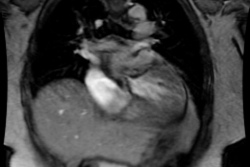Noncompaction cardiomyopathy:
- Clinical:
Noncompaction cardiomyopathy (sponge myocardium) is a rare congenital disorder caused by intrauterine arrest of endomyocardial compaction which causes the embryonic myocardium to persist [1]. The disorder primarily affects the left ventricle, with concomitant right ventricular involvement in 41% of patients [1]. The condition leads to systolic and diastolic ventricular dysfunction [1]. The disorder most commonly extends from the apex along the lateral and inferior wall to the mid portion of the LV [1]. There is no specific treatment for the disorder [1]. Prognosis depends on the degree of LV dysfunction and whether complications such as arrhythmias are present [1].- X-ray:
The imaging hallmark of the disorder is an overall increase in myocardial thickness with a two-layer structure that consists of a thin, compacted subepicardial layer and a thicker noncompacted subendocardial layer [1]. At echo, the threshold for diagnosing noncompaction cardiomyopathy is a maximal endsystolic noncompacted to compacted ratio of more than 2 in the short axis view [1].REFERENCES:
(1) Radiographics 2013; Stojanovska J, et al. Congenital and hereditary causes of sudden cardiac death in young adults: dianosis, differential diagnosis, and risk stratification. 33: 1977-2011





